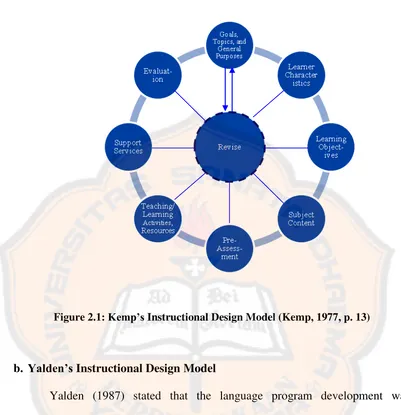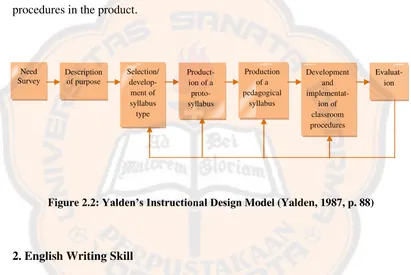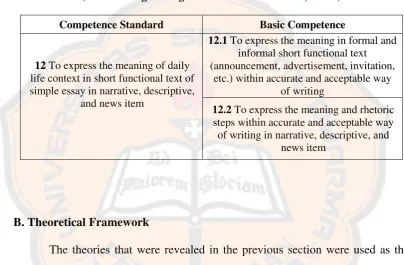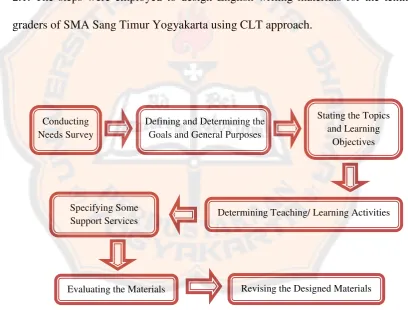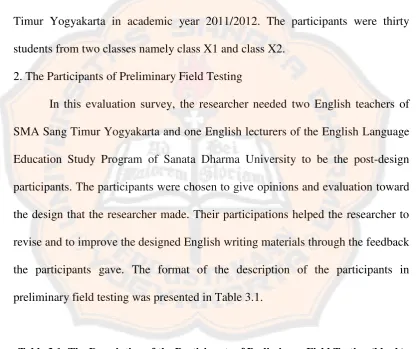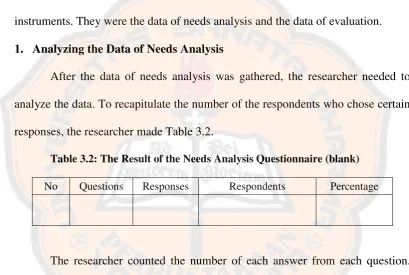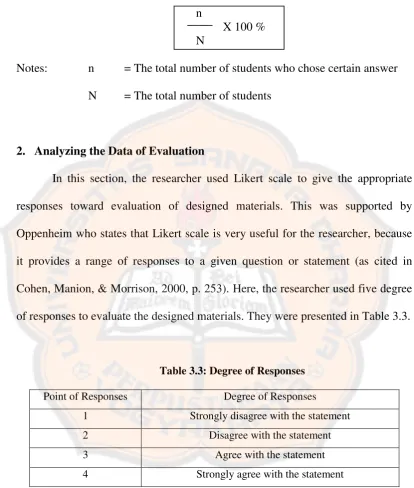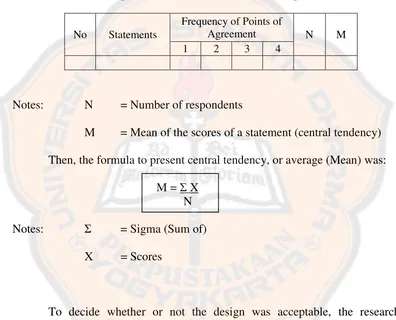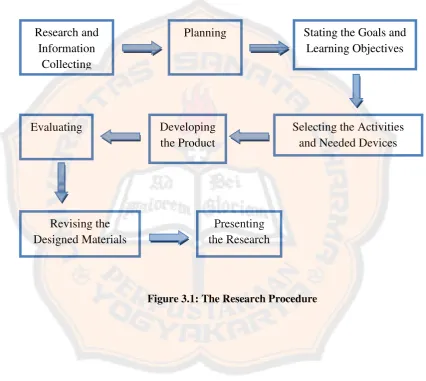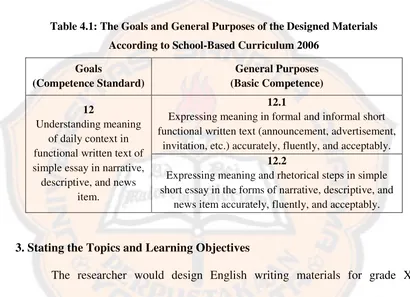LANGUAGE TEACHING APPROACH FOR GRADE X STUDENTS OF SMA SANG TIMUR YOGYAKARTA
A SARJANA PENDIDIKAN THESIS
Presented as Partial Fulfillment of the Requirements to Obtain the Sarjana Pendidikan Degree
in English Language Education
By
Hedwig Alfa Karlinda Student Number: 071214031
ENGLISH LANGUAGE EDUCATION STUDY PROGRAM
DEPARTMENT OF LANGUAGE AND ARTS EDUCATION
FACULTY OF TEACHERS TRAINING AND EDUCATION
SANATA DHARMA UNIVERSITY
YOGYAKARTA
iv
I dedicated this valuable thesis to: Holy TRINITY
Mum and Dad
the whole world
YOU have granted me
life and favor,
And YOUR care has
preserved my spirit.
Job 10:12
…… aktor perubahan pendidikan di
negeri ini, hanya guru, tentu saja
setelah guru sendiri berubah ……
vii
Karlinda, Hedwig Alfa. (2012). English Writing Materials Using Communicative Language Teaching Approach for Grade X Students of SMA Sang Timur Yogyakarta. Yogyakarta: English Language Education Study Program, Sanata Dharma University.
English writing is a skill that is often neglected. The skill is essential, but it is difficult to understand. Therefore, many tenth graders in SMA Sang Timur Yogyakarta feel bored in the learning process of English writing when they have to integrate ideas and grammar. Another reason is students do not like grammar in writing. They are not interested in grammar because grammar is a difficult material. From those reasons, the researcher designs English writing materials for grade X students of SMA Sang Timur Yogyakarta, in where grammar material is included. In this study, the researcher employs an approach named Communicative Language Teaching (CLT) approach. The approach will help students comprehend the materials in communicative ways.
This study focused on two research problems. They were: (1) How are English writing materials for grade X students of SMA Sang Timur Yogyakarta designed? And (2) What does the design of English writing materials for grade X students of SMA Sang Timur Yogyakarta look like?
In answering the first problem of this study, the researcher employed the procedure which was taken from the combination of Kemp’s and Yalden’s
Instructional Design (ID) models and Borg and Gall’s Research and Development
(R&D) cycle. The steps were: (1) conducting needs survey, (2) defining and determining the goals and general purposes, (3) stating the topics and learning objectives, (4) stating teaching/learning activities, (5) specifying some support services, (6) evaluating the materials, and (7) revising the designed materials. The instruments the researcher employed were interview guide and questionnaire, where interview was conducted in needs survey and questionnaire was distributed in both needs survey and evaluation. From the result of evaluation, it was found out that the average (Mean) was 3.375 from the scale 4.0. It could be indicated that the designed materials were good and acceptable.
In answering the second problem of the study, the researcher presented the final version of English writing materials. The materials consisted of six units. Those units consisted of five sections. They were: (1) Roll Your Board, (2)
Grammar Zone, (3) Happy Writing, (4) Get Betterment, and (5) End It Well. Hopefully, the designed materials will be beneficial for grade X students of SMA Sang Timur Yogyakarta to comprehend English writing materials and to apply the meaning of communication in writing skill.
viii
Karlinda, Hedwig Alfa. (2012). English Writing Materials Using Communicative Language Teaching Approach for Grade X Students of SMA Sang Timur Yogyakarta. Yogyakarta: Program Studi Pendidikan Bahasa Inggris, Universitas Sanata Dharma.
Menulis adalah keterampilan dalam Bahasa Inggris yang sering diabaikan. Keterampilan ini penting, tetapi susah untuk dipahami. Oleh karena itu, banyak siswa kelas X di SMA Sang Timur Yogyakarta merasa bosan dalam proses pembelajaran menulis saat siswa harus menggabungkan ide dan tata bahasa. Alasan lainnya adalah siswa tidak menyukai tata bahasa. Mereka tidak tertarik untuk mempelajari tata bahasa karena merupakan materi yang sulit. Dari kedua alasan tersebut, peneliti merancang bahan pembelajaran menulis Bahasa Inggris untuk siswa kelas X SMA Sang Timur Yogyakarta, yang juga menyertakan materi tata bahasa. Dalam penelitian ini, peneliti menggunakan sebuah pendekatan yaitu Pengajaran Bahasa Komunikatif. Pendekatan ini akan membantu para siswa untuk memahami materi dengan cara komunikatif.
Studi ini membahas dua permasalahan. Kedua permasalahan tersebut ialah (1) bagaimanakah materi pembelajaran Bahasa Inggris dalam keterampilan menulis untuk para siswa kelas X SMA Sang Timur Yogyakarta dirancang? Dan (2) seperti apakah materi Bahasa Inggris tersebut?
Untuk menjawab permasalahan pertama, peneliti membuat langkah-langkah yang diambil dari kombinasi model Rancangan Pembelajaran milik Kemp dan Yalden, dan siklus Penelitian dan Pengembangan Materi milik Borg dan Gall. Langkah-langkah tersebut yakni: (1) mengadakan survey kebutuhan, (2) menentukan tujuan umum pembelajaran, (3) menentukan topik dan tujuan pembelajaran, (4) merumuskan kegiatan belajar/mengajar, (5) merumuskan bahan-bahan pendukung, (6) mengevaluasi materi, dan (7) merevisi materi yang telah dirancang. Instrumen yang digunakan ialah wawancara dan kuesioner, di mana wawancara digunakan saat survey kebutuhan, dan kuesioner digunakan saat survey kebutuhan dan evaluasi. Dari hasil evaluasi, peneliti menemukan bahwa nilai rata-rata yang didapat adalah 3.375 dari nilai maksimum 4.0. Hal ini menunjukkan bahwa materi yang telah dirancang adalah baik dan diterima.
Untuk menjawab permasalahan kedua, peneliti mempresentasikan versi akhir materi pembelajaran menulis yang telah dirancang. Materi ini terdiri dari enam unit. Setiap unit memiliki lima bagian, yaitu: (1) Roll Your Board, (2)
Grammar Zone, (3) Happy Writing, (4) Get Betterment, dan (5) End It Well. Peneliti berharap bahwa materi ini akan berguna bagi para siswa kelas X SMA Sang Timur Yogyakarta untuk memahami materi pembelajaran menulis Bahasa Inggris dan mengaplikasikan arti komunikasi dalam keterampilan menulis.
ix
First of all, I would like to thank the ALMIGHTY TRINITY, for the blessings that my FATHER always gives, whenever and wherever I need, through HIS SON, JESUS CHRIST, and HOLY SPIRIT who gives the happiness spirit to finally accomplish this thesis.
In this opportunity, I would like to give the deepest, sincere, and tender
thankfulness to my advisor, Made Frida Yulia, S.Pd., M.Pd. for her fresh encouragement, warm advice, and tender assistance. I would also like to thank
Drs. JB Gunawan, M.A., as my academic advisor, Yuseva Ariyani Iswandhari, S.Pd., M.Ed., as an English writing expert, and Mega Wulandari, S.Pd., for her great advice.
Then, my deep gratitude is also addressed to Sr. Hilaria, PIJ, as the principal of SMA Sang Timur Yogyakarta. I would like to thank her for the
permission to conduct the research. I would also like to thank Yovita Maharani, S.Pd. and Drs. M. Heri Cahyono, as the English teachers in SMA Sang Timur Yogyakarta, for their support and prayer addressed to me. My special thanks also
go to the tenth graders of SMA Sang Timur Yogyakarta as the respondents of my study.
Special thanks I also address to my parents who always support me, pray
x
Yolanda, Dwi, Rani, Bertin, Winda, Veli, Nia, Via, Sima, Irma, Ria, Indah, Nani,
kak Dara, kak Tyas, kak Tanti, kak Ayek, kak Ena, Sefin, Fetra) in ‘Pondok
Angela’ dormitory. I thank them all for their support.
I would also like to thank Valentina Dyah Arum Sari, S.Pd., Yustinus Calvin Gai Mali, S.Pd., Agnesia Febriani, S.Pd., Gabriella Novianty, S.Pd., Herdiansari Hayuningrum, S.Pd., Fendika Aji Prawisma, S.Pd., Wendy Rahmad Biyandi, S.Pd., Maria Assumpta Deny, S.Pd., Dwi Yulianto Nugroho, S.Pd., Angela Merici Y.K.D., S.Pd., Widi Astuti, S.Pd., Sance Maharsi, S.Pd., Yunita Sulistyaningsih, S.Pd., for their advice related to my thesis progress. To all PBI 2007 students, I would like to thank them for always supporting each other.
I would also like to thank pak Endra ‘Ndut’, mas Diyan ‘Catax’, mas
Wijaya ‘Sapi’, mas Ganang ‘Domex’, kak Hendra ‘Cindil’, mas Dika ‘Doler’ and
Bitbit ‘Chibi’, for daily advice and happiness we share. I would also like to thank
my friends from St. Yohanes Krisostomus Readers Community (mas Nanda,
bang Koko, Siddhi ‘Cici-Koko’, Arum, Laura, Daniel, Jolin, Helga, Yeffri, and so
forth) and St. Yohanes Rasul Pringwulung Parish (Rm. Subi, Rm. Toto, Rm. Erwin, mas Kelik, pak Raharjo) for praying for me always.
Last but not least, I would also like to all people who have helped me,
have prayed for me, whose names cannot be mentioned one by one.
GOD is with us. Amen.
xi
Page
TITLE PAGE ………... i
APPROVAL PAGES ……….. ii
DEDICATION PAGE ………. iv
STATEMENT OF WORK’S ORIGINALITY ……… v
PERNYATAAN PERSETUJUAN PUBLIKASI ……… vi
ABSTRACT ……… vii
ABSTRAK ………viii
ACKNOWLEDGEMENTS ……… ix
TABLE OF CONTENTS ……… xi
LIST OF TABLES ……….xiv
LIST OF FIGURES ……… xv
LIST OF APPENDICES ………..xvi
CHAPTER I. INTRODUCTION 1
A.Research Background ……… 1
B.Research Problem ………. 5
C.Problem Limitation ……… 6
D.Research Objectives ………. 6
E. Research Benefits ……… 7
F. Definition of Terms ………. 7
CHAPTER II. REVIEW OF RELATED LITERATURE 10
xii
a. Kemp’s Instructional Design Model ……… 10
b. Yalden’s Instructional Design Model ……….. 14
2. English Writing Skill ……… 18
a. Definition of Writing ……….. 19
b. The Writing Process ……… 19
c. Principles of Teaching Writing ………... 22
d. Writing Tasks ……… 23
e. Starting Strategies in Writing Class ……… 25
3. Communicative Language Teaching Approach ……….. 26
a. Theory of Language ……… 27
b. Theory of Learning ………. 28
c. Procedure ……… 29
d. Teacher Roles ………. 30
e. Learner Roles ………. 30
4. School-Based Curriculum ……… 30
B.Theoretical Framework ………. 31
CHAPTER III. METHODOLOGY 35
A.Research Method ……… 35
B.Research Setting ………. 37
C.Research Participants ………. 38
D.Instruments and Data Gathering Technique ……… 39
1. Research Instruments ……… 39
xiii
1. Analyzing the Data of Needs Analysis ……… 42
2. Analyzing the Data of Evaluation ……… 43
F. Research Procedure ………. 45
CHAPTER IV. RESEARCH RESULTS AND DISCUSSION 49
A. The Steps of Designing English Writing Materials ……… 49
1. Conducting Needs Survey ……… 49
a. Data from Conducting Interview ……… 50
b. Data from Distributing Questionnaire ………. 51
2. Defining and Determining the Goals and General Purposes ………. 52
3. Stating the Topics and Learning Objectives ……… 53
4. Stating/ Teaching Learning Activities ……… 55
5. Specifying Some Support Services ………. 57
6. Evaluating the Materials ……….. 57
7. Revising the Designed Materials ………. 59
B. The Presentation of the Designed Materials ……… 60
CHAPTER V. CONCLUSIONS AND RECOMMENDATIONS 62
A. Conclusions ………. 62
B. Recommendations ……… 64
xiv
Table Page
2.1 Competence Standard and Basic Competence of Writing Skill
of School-Based Curriculum for Grade X in English Subject ……… 31
3.1 The Description of the Participants of Preliminary
Field Testing (blank) ……….……….. 38
3.2 The Result of the Needs Analysis Questionnaire (blank) ……… 42
3.3 Degree of Responses ……… 43
3.4 The Description of Evaluation Form of
the Designed Materials (Blank)……… 44
4.1 The Goals and General Purposes of the Designed Materials ………. 53
4.2 Text Genres, Topics, and Learning Objectives ……….. 54
4.3 The Description of the Participants of Preliminary Field Testing ……….. 58
4.4 Points of Agreement ……….. 58
xv
Figure Page
2.1 Kemp’s Instructional Design Model ……… 14
2.2 Yalden’s Instructional Design Model ..……… 18
2.3 The Steps in Designing English Writing Materials ………. 34
xvi
Appendix Page
APPENDIX 1 Research Permission Letter from
Sanata Dharma University ……….. 70
APPENDIX 2 The Result of Interview of the Needs Analysis ………. 72
APPENDIX 3 A Sample of Questionnaire of the Needs Analysis (blank) … 74
APPENDIX 4 The Result of Questionnaire of the Needs Analaysis ……. 77
APPENDIX 5 A Sample of Questionnaire of the Evaluation (blank) ……. 80
APPENDIX 6 The Result of Questionnaire of the Evaluation ………. 84
APPENDIX 7 The General Description of the Designed Materials ………. 87
APPENDIX 8 The Syllabus of the Designed Materials ……… 91
APPENDIX 9 The Lesson Plans of the Designed Materials ………. 97
APPENDIX 10 English Writing Materials Using Communicative
Language Teaching Approach for Grade X Students
1
INTRODUCTION
This chapter presents research background, research problem, problem
limitation, research objectives, research benefits, and definition of terms.
A. Research Background
English has become more popular and important. The language which is
used mostly spreads rapidly and brings the impact for people. The popularity
requires people to use the language, at least to understand the meaning. It can be
seen in sentences or words people find in advertisements, public transportations,
or food cans. English has become the bridge of communication throughout the
world.
However, communicating in English is not easy to do for people who live
in non-English-speaking countries, such as Indonesia. Supriyoko (2000) says that
Indonesia government has decided to set English as a foreign language in
Indonesia, based on the policy of Minister of Education and Culture no. 096 year
1967. Moreover, Gebhard (1996) adds that the primary goal for children studying
English in the educational system is to pass English entrance exams to enter good
high schools and universities (p. 2). It is clear that English is only studied for
certain purpose. For that reality, EFL teachers have to face the responsibility in
having to teach and to test, having too little time with students, and asking
students to take on more responsibility for their learning (p. 3).
Talking about English as a Foreign Language (EFL) in Indonesia, it is
obviously revealed by Setiyadi (2006) that learning English here is discussing
about the grammatical rules and sentences erroneous in English (p. 21). English
learners here focus on the accuracy, while English as a Second Language (ESL)
people emphasize the ability and fluency of using English. The accuracy is
displayed when learners speak, or write something. Speaking and writing, as the
two of four language skills, actually is not easy to gain. EFL learners should be
able to gain the intention of two supportive skills namely listening skill and
reading skill. Here, the researcher chooses writing as the main zone to research.
Writing is a skill that is often neglected. It is stated by Riddell (2003) that
some teachers do not know how to teach writing well with the appropriate way (p.
138). Whereas, writing can be very important for students to prepare for an exam.
He reveals that writing is an important part of the curriculum in schools from the
earliest grades onward, and that most children in countries that have a formal
education system will learn to write, at least at a basic level. Writing is essential,
but the skill is the most difficult.
Based on the researcher’s experience when teaching English in senior high
school, the researcher found that students, especially grade X students, felt bored
when learning writing. Students also said that writing was difficult, when
writer, generates the ideas, as with speaking, there are some difficult steps the
writer takes commonly. The first step is easy when the writer verbalizes what he is
thinking. Then, the next step is the problem when the writer begins to use written
language, for then he is faced with spelling, the mechanics, and the physical labor
of writing each word (p. 6). This can be seen, in communication, that writing has a
slower process than speaking.
Another reason which makes students feel difficult and bored was
grammar. Students once complained to the researcher about the existence of
complicated grammar in writing. Students said that they did not like grammar,
although they always realized that grammar was very important. The reason also
came from the English teachers in school where the researcher had teaching
practice. Teachers said that they had tried to teach grammar in writing with proper
ways. However, students were also uninterested in learning. It could be seen from
the complaint and scores.
The importance of grammar in writing is stated by Frodesen, who says that
grammar in writing that emphasizes a focus on form in composition can help
writers develop rich linguistic resources needed to express ideas effectively in
addition to providing assistance in error correction (as cited in Celce-Murcia,
2001, p. 233). Further, the importance has been realized in the Middle Ages in
Europe, as stated by Purpura (2004), that grammar was used to mean the analysis
of a language system, and the study of grammar was not just considered an
central role in language teaching at that time. It can be simplified that grammar
cannot be separated from writing. It is because grammar helps writers improve
their knowledge in writing, when they find the mistakes in writing, realizing that
they are writing in English, the foreign language in Indonesia.
Considering the reasons, the researcher is interested to design English
writing materials by using an approach that will let the communication between
two parties occur well. A reason for involving communication in this study is the
communicative approach will give great function to help students more
understand the materials. According to Richards and Rodgers (1981), the
approach that reveals the communicative view of language and language learning,
and supports the variety of teaching-learning procedures is Communicative
Language Teaching approach (p. 172). One of the principles that the approach has
is authentic and meaningful communication should be the goal of classroom
activities. Related to writing, the communicative activities will bring the
comprehension to students, as the goal, when they are learning writing. Thus,
writing is not the passive activity anymore, which involves students only to write
and write anything. The meaningful activities also derives from the distinctive
features of Communicative Language Teaching approach, according to
Finocchiaro and Brumfit (as cited in Richards & Rodgers, 1981, p. 156), that
students are expected to interact with other people, either in their writing
products. Due to the unlimited activities of using the approach, the communicative
communication.
Further, Communicative Language Teaching approach is able to help
students more comprehend the materials given. Here, Richards and Rodgers
reveal that the approach provides some appropriate materials for students, one of
which is realia, a from-life material, such as magazines and pictures (p. 170).
Magazines and pictures can be used in teaching writing. The discovery of
communicative competence will be released when writing is involved in this kind
of activity. The unlimited scope of activities will enable students to comprehend
and improve their writing’s ability.
From those reasons, the researcher’s interest to design English writing
materials is expressed. Then, SMA Sang Timur Yogyakarta, a high school in
Yogyakarta where the researcher did teaching practice in her PPL (Program Pengalaman Lapangan) in July-September 2010, is the chosen school. Further,
the designed materials will be dedicated to grade X students as the target learners
of the study. From this view, the researcher expects students to enjoy the
communicative activities and to be able to improve their writing’s ability when
students are going to take a higher grade.
B. Research Problem
The problems of this research can be formulated as follows.
1. How are English writing materials for grade X students of SMA Sang Timur
SMA Sang Timur Yogyakarta look like?
C. Problem Limitation
To limit the scope of the study, the researcher will focus on three
limitations. First, the researcher only focuses on designing the English writing
materials. The materials will be designed according to students’ needs and ability,
and the scope of materials will be based on School-Based Curriculum (KTSP)
2006. Second, the approach that will be used in this study is Communicative
Language Teaching approach, which eases students to learn English writing
communicatively. Third, the target learner of this study is grade X students who
are able to improve writing’s ability when they are going to take the higher grade.
SMA Sang Timur Yogyakarta is the school where the researcher did the teaching
practice. The researcher chooses SMA Sang Timur Yogyakarta because the school
has potency in English writing which is able to be bloomed. The population used
in the research will be only about thirty students from two classes.
D. Research Objectives
The objectives of this research are decided as follows.
1. To find out how English writing materials for grade X students of SMA Sang
Timur Yogyakarta are designed.
2. To find out the design of English writing materials for grade X students of
The study is intended to gain some benefits. Those are:
1. For English teachers of SMA Sang Timur Yogyakarta
The materials that are designed by the researcher can be used for
enhancing students’ writing ability. The design is also able to help teachers to
teach in better techniques and to create an innovative ways in teaching English
writing.
2. For grade X students
The materials will be beneficial for grade X students to expand and
increase their knowledge in English writing. Students can also develop their
writing ability in communicative competence.
F. Definition of Terms
Avoiding the different and ambiguous perception, the researcher will give
the definition of the terms related to this research.
1. Designing
Hornby (2000) defines that to design is to decide how something will look
and work, especially by making plans, drawings or models of it. He also states
that to design is to think of and plan a system and procedure (p. 344). Then,
designing instructional materials which is explained by Gagné and Briggs (1974)
is designing a set of events which affects learners, while instruction is planned
determining the students’ needs based on the curriculum.
2. Writing
Tiedt (1989) defines that writing is a method of expressing ideas about any
subject content. Then, it appears in classrooms everywhere and, therefore, writing
must be the concern of every teacher (p. 1). Further, Weigle (2002) adds that the
ability to write a second language has become the essential thing in educational,
business, and personal reasons (p. 1). In this study, the researcher designs
materials which focus on certain genres related to writing materials for grade X
students.
3. Communicative Language Teaching Approach
Richards and Rodgers (2001) define that Communicative Language
Teaching is an approach that aims tomake communicative competence the goal of
language teaching, and to develop procedures for the teaching of the four
language skills that acknowledge the interdependence of language and
communication (p. 155). They also state that Communicative Language Teaching
means little more than an integration of grammatical and functional teaching. The
definition is argued well by Weigle (2002) that communicative language teaching
is “teaching language as a system of communication rather than as an object of
study” (p. 1). Therefore, experts say that communicative approach has a function
in the form of the language serve. The essential thing in this approach, according
to Littlewood (1981), is there are at least two parties involved in an interaction,
make the learning activities comfortable. Here, students are invited to involve in
communicative learning activities.
4. Grade X Students
Grade X students are students who are learning and studying in the first
year of senior high school. The chosen school here is SMA Sang Timur
Yogyakarta which is located in Bathikan, Umbulharjo, Yogyakarta. In this
research, the researcher designs English writing materials using Communicative
10
REVIEW OF RELATED LITERATURE
In this chapter, the researcher discussed review of literature related to this
study. This section was divided into two parts. The first part was theoretical
description and the second part was theoretical framework.
A. Theoretical Description
This section was related to the theories that support this study. In this part,
the researcher discussed and elaborated the theories about the Instructional Design
models, the theories of English writing, the theories of Communicative Language
Teaching approach, and School-Based Curriculum.
1. Instructional Design Models
In this research, the researcher presented two instructional design models
that would be the main references to arrange the design. They were:
a. Kemp’s Instructional Design Model
The first instructional design model used as the reference for the
researcher was Kemp’s model. According to Kemp (1977), instructional design
was applied to answer three questions which were essential in an instructional
design (p. 8). Those three important elements were objectives (What must be
to reach the desired learning levels?), and evaluation (How will we know when
the required learning has taken place?). Besides those three important elements,
Kemp also revealed eights steps of designing the materials. They were:
1) Considering goals, listing topics, and stating the general purposes for teaching
each topic
About this first step, Kemp (1977) stated, “instructional design planning
started with the recognition of the broad goals of the school system or institution”
(p. 13). The starting points were to consider the goals related to subject areas, to
select the topics according to subject preference or teaching experiences, and to
state the general purposes which were more specific as the learning outcomes
from students (p. 16).
2) Enumerating the important characteristics of the learners for whom the
instruction is to be designed
Here, Kemp (1977) conveyed that the designer should recognize and
regard the student as an individual learner since the designer’s success would be
measured from this (p. 18). Realizing students as the respondents in designing the
materials, Kemp suggested that the designer should consider learning conditions
referring to “groups of factors that could affect a persons’ ability to concentrate,
absorb, and retain information” (p. 19). Then, learning styles which would help
the designer as it gave the description of an individual’ learning style. The
designer would be able to diagnose how a learner accomplished particular tasks
3) Specifying the learning objectives to be achieved in terms of measurable
student behavioral outcomes
Kemp (1977) said that this step was difficult, but essential in designing the
materials since learning was the outcome of instruction (p. 23). He also stated that
objectives delivered to students were the goals that students must attained, the
ideas and skills that would be included in the design, and the types of behavior
that would be expected during evaluation (p. 40). Further, Kemp conveyed the
three major categories of objectives, namely cognitive domain which was the
domain that the designer gave most attention to an educational program (p. 24),
psychomotor domain which was the domain that required the coordination of
skeletal muscles in the physical activities (p. 25), and affective domain which was
the domain that focused on attitudes, appreciations, values, and all emotions (p.
26).
4) Listing the subject content that supports each objective
According to Kemp (1977), subject content focused on the selection and
organization of the specific knowledge (facts and information), skills
(step-by-step procedures, conditions, and requirements), and attitudinal factors of any topic
(p. 44).
5) Developing pre-assessments to determine the student’s background and
presenting level of knowledge about topic
In this step, Kemp (1977) stated two information of pre-assessment,
appropriate background preparation for the topic” (p. 51) and pretesting which
was a pretest of the selected topic and was conducted to give the result about the
objectives that students might have attained.
6) Selecting teaching/learning activities and instructional resources that will treat
the subject content so students will accomplish the objectives
Kemp (1977) revealed that the essence of this step was there was no
formula to match activities to objectives. Here, the designer should know the
strengths and the weaknesses of each alternative method, since the selected
activities might not work well. Then from this, the designer could make the better
methods in teaching-learning process. (p. 56).
7) Coordinating such support services as budget, personnel, facilities, equipment,
and schedules to carry out the instructional plan
Kemp (1977) said, “support services had to be considered at the same time
instructional plans were being made and materials being selected” (p. 85).
8) Evaluating students’ learning in terms of their accomplishment of objectives,
with a view to revising and reevaluating any phases of the plan that need
improvement
According to Kemp (1977), this step required the designer to measure the
learning outcomes related to the objectives. The designer could do
paper-and-pencil testing, evaluating psychomotor and affective domain, and testing with
other materials, such as pictures, audio recordings, photographs, or video tape
Figure 2.1: Kemp’s Instructional Design Model (Kemp, 1977, p. 13)
b. Yalden’s Instructional Design Model
Yalden (1987) stated that the language program development was
connected with the specification of syllabus construction (p. 85). From this, she
said that the designer conducted communicative use of language as well as
linguistic structure and general usage. In her book, she revealed steps of designing
materials (pp. 88-89). They were:
1) Needs survey
Yalden (1987) stated that need survey, “entailed carrying out a survey of
prepared as well as a survey of the physical resources at hand” (p. 88). Further, he
revealed, “needs survey also included the learner’s own desires or wants, seen
more subjectively in terms of self-expression and less in terms of purposeful or
transactional communicative behavior” (p. 103).
2) Description of purpose
Yalden (1987) conveyed that the more accurately the teacher can predict
learners’ needs, the more clearly a purpose could be delineated (p. 105).
3) Selection or development syllabus type
Yalden (1987) delivered that no single model of syllabus design which
was accepted universally (p. 108). Then, she assumed communicative as the way
to represent the environment of real language use, and communicative syllabus
existed here (p. 109). There were types of communicative syllabus. They were:
a) Structural-Functional Type
Yalden (1987) said, “this was a separation of the two components of form
and communicative function was maintained, and it was relatively implemented”
(p. 110).
b) Structures and Function Type
Related to this, Brumfit stated that it was sensible to provide learners with
the tools for linguistic system rather than teaching them about what to do with the
tools, since cultural and language meaning was argued between users of a
language (as cited in Yalden, 1987, p. 111). Then, this type of syllabus helped the
c) Variable Focus Type
Allen introduced this type of communicative syllabus, where a three-level
ESL syllabus was synthesized. This type emphasized the change of formal
features language to rhetorical (discourse) features, to the instrumental use of
language (as cited in Yalden, 1987, p. 114).
d) Functional Type
Yalden (1987) said that objectives were stated primarily in terms of
communication functions, not in terms of linguistic or ideational content (p. 115).
e) Fully Notional Type
Wilkins defined, “This type was the strongest possible approach to the
input syllabus” (as cited in Yalden, 1987, p. 115). This syllabus did not require the
elaboration of the subject. Yalden (1987) stated that the notional syllabus
depended on the context and put a concern to what to communicate when people
spoke or wrote (pp. 42-43).
f) Fully Communicative Type
Yalden (1987) said that this would be the minimal input syllabus, since
this was out of a concern with methodological problems and solutions (p. 116).
However, Allwright suggested the teacher could use this type of syllabus to solve
communication problem and language learning would run smoothly (as cited in
4) Production of proto-syllabus
Yalden (1987) said that at this step the syllabus designer would consider
the description of syllabus content, such as the preparation of syllabus
specifications (p. 138). However, there were some considerations before the
designer thought in beginning. First, it was not always possible to include all
things the designer needed in teaching the subject. The designer tried to reduce the
process to manageable proportions. Second, the designer described the general
purpose of the course at an early stage. Third, the specification of target levels
should be conveyed with early attention (p. 139).
5) Production of pedagogical syllabus
Yalden (1987) said, “this was some of the apparent difficulties
surrounding early formulations of the functional approach could be resolved” (p.
143). Since the components produced in the proto-syllabus stage were only
viewed as the guidelines, the components in this pedagogical syllabus were a
specification of what to learn in the course.
6) Development and implementation of classroom procedures
When the designer developed the procedures, he had to focus on selection
of exercise types and teaching techniques, and preparation of lesson plans and of
weekly schedules. Then for implementation, the designer had to focus on the
7) Evaluation
Figure 2.2: Yalden’s Instructional Design Model (Yalden, 1987, p. 88)
2. English Writing Skill
Writing was essential. It was stated by Elite Olshtain that writing now was
viewed by people as a communication within a text. Moreover, technology
required communication via writing such as in electronic document (as cited in
Celce-Murcia, 2001, p. 207). However, people realized that writing lacked of
feedback as it was in speaking. Thus, it was common now that many activities of
learning writing. Then, before getting to know about activities in writing, this
section would discuss the definition of writing.
a. Definition of Writing
In order to make a clear explanation of writing, the researcher began by
defining writing skills according to some experts. Tiedt (1989) defined that
writing was a one way to express an idea related to anything. As writing was the
concern of every teacher, it appeared in every learning in the classrooms (p. 1).
Further, Maggie Sokolik defined writing as the series of contrasts (as cited
in Nunan, 2003, p. 88). They were:
1) It was both a physical and a mental act. Here, writing was the act of
committing words or ideas to some written text. Besides, it was a mental work
of inventing ideas, thinking about how to express them, and organizing them
into statements and paragraphs that would be clear to a reader.
2) It was writing which aimed to express and impress. Writers were the master of
the text and they needed audience to express it. Then, writers chose the best of
their writings. This aimed to obtain impression from the audience.
3) Writing was a process and a product. The process was imaging, organizing,
drafting, editing, reading, and rereading, while the product was as essay, letter,
story, or research report.
b. The Writing Process
As people perceived writing was the one way to express thinking, the
writing were dominated with frequent writing. Thus, Tiedt (1989) gave the basic
understandings about the writing process as the foundation of expressing thinking
(pp. 3-7). They were:
1) Students learn to write by writing
In order to make students capable of producing a writing product, they
should write something. A teacher could give instruction and guidance to the
novice writers.
2) Writing expresses thinking
In teaching writing, a teacher guided students to understand about the
relationship between thinking and the writing process, where the writing process
was collecting, processing, and publishing data.
3) Students learn to write by reading
It would be essential for students to know how an author of a writing
product wrote that form before they produced that. They observed how he
presented the ideas, used a language, and made the structured sentences in his
writing product.
4) Writing is not easy
Many people said that writing was not easy. Thus, Tiedt conveyed that the
way to remove the difficulties of writing in people or students’ thought was to
Besides the explanation above, the writing process was admitted necessary
also in a writing classroom. Here, writing was designed as a way of learning,
which the learners could apply the knowledge of writing in a learning process.
The learning process in a writing classroom had the steps. They were:
1) Prewriting Activities
According to Tiedt (1989), everything that brought up a writing experience
could be said as prewriting stimulus, or prewriting activities (p. 11). He said that
beginning the lessons by giving prewriting activities aimed to give meaning for
each student, and to help them bring out ideas related to the topic.
2) Writing Activities
Jan Frodesen said that grammar in writing emphasized a focus on form in
composition, and it could help writers develop rich linguistic resources needed to
express ideas. He also said that grammar was an integral part of language use and
it was a resource to be accessed for effective communication, not just an isolated
body of knowledge (as cited in Celce-Murcia, 2001, p. 233-234).
The existence of the acquisition of grammar information which preceded
the main activity in writing class was assumed by Tiedt (1989). He said that
grammar should be provided as a facilitation of how English was used so that
students could then test the grammar knowledge against knowledge they had
acquired when they produced sentences (p. 63). Furthermore, this section
provided more opportunities to students to write, as Larsen-Freeman (2000) stated
(p. 126). Then, Maggie Sokolik justified that writing was a mental work of
inventing ideas, thinking about how to express them, and organizing them into
statements and paragraphs that would be clear to a reader (as cited in Nunan,
2003, p. 88).
3) Post Writing Activities
Tiedt (1989) stated that editing or evaluating students’ writings was
essential as they were involved directly in the process of improving writing
products. Then, students should know the specific ways to produce better writings
(p. 24). He also stated that evaluating the lesson section should provide students
frequent opportunities to give response toward the writing lessons (p. 14).
Moreover, Joyce (2002) says that reflection helps students reduce error in their
writings.
c. Principles of Teaching Writing
According to Maggie Sokolik, writing teachers should understand the
principles of teaching writing, whether it was a course, or a course in which
writing would play (as cited Nunan, 2003, p. 92). They were:
1) Understanding students’ reasons for writing
It was essential to know, to understand, and to convey goals to students in
ways that made sense to them. It was because all teachers would obtain
dissatisfaction when the teacher’s goals did not match the students’ reasons, or
when the teacher’s goals do not match those of school or institution in which the
2) Providing many opportunities for students to write
Since writing was a physical activity, it required practice to obtain the
improvement. Students would become more comfortable with the act of writing
when practice writing sessions were integrated regularly into the syllabus or
planning.
3) Make feedback helpful and meaningful
Because students craved feedback on their writing, the teacher should
make sure that students understand the vocabulary, symbols used, and the tone of
the comment. The teacher should know that feedback instructed students to look
for problems and correct them on their own, in order to foster independent writers.
d. Writing Tasks
In many schools, all English teachers taught students to write in English
within activities which could help students arise their motivation. Here, Elite
Olshtain described the development of writing tasks (as cited in Celce-Murcia,
2001, p. 211). They were:
1) Task description. It aimed to present students with the goal of the task and its
importance.
2) Content description. It aimed to present students with possible content areas
that might be relevant to the task.
3) Audience description. It aimed to guide students in developing an
understanding of the intended audience, their background, needs, and
4) Format cues. It helped students in planning the overall organizational structures
and vocabulary choices.
5) Spelling and Punctuation. This helped students focus their attention on spelling
rules which they had learned and eventually on the need to use the dictionary
for checking accuracy of spelling, and to guide students to use acceptable
punctuation and capitalization conventions.
According to Barbara Kroll, the key component of all writing class was
writing assignments. The writing course consisted of a series of assignments that
were targeted and students were supposed to achieve the target, as the object of
any writing class was to have students work on their writing (as cited in
Celce-Murcia, 2001, p. 225). Regarding the assignments as one way to achieve the
objectives of lesson, Barbara Kroll gave the guidelines to have successful writing
assignments (as cited in Celce-Murcia, 2001, p. 226). They were:
1) A writing assignment had to be presented with its context clearly delineated
such that the student understood the reasons for the assignment.
2) The content of the task/topic had to be accessible to the writers and allow for
multiple approaches.
3) The language of the prompt or task and the instruction it was embedded in had
to be unambiguous, comprehensible, and transparent.
4) The task had to be focused enough to allow for completion in the time or
length constraints given and had to further students’ knowledge of classroom
5) The rhetorical specifications (cues) had to provide a clear direction of likely
shape and format of the finished assignment, including appropriate references
to an anticipated audience.
6) The evaluation criteria had to be identified so that students would know in
advance how their output would be judged.
Finally, Barbara Kroll stated that the emphasis of writing was the key to
successful writing class. It was students would best learn by writing and the
assignments would give students the feedback to revise and improve their writing,
although teaching EFL students to become successful writers was not easy. This
was because students had to learn linguistic and content competences (as cited in
Celce-Murcia, 2001, p. 230).
e. Starting Strategies in Writing Class
Realizing that writing was not easy, writing should be started with easy
ways. These were techniques for starting writing in the classroom. They were:
1) Brainstorming
Maggie Sokolik stated that it was an activity which required students to
list all the ideas they could think of related to a topic. This could be done
individually or in pairs or groups (as cited in Nunan, 2003, p. 97). Barbara Kroll
added that here students could use any information when thinking of on his or her
2) Wordmapping
Maggie Sokolik defined this was an activity which required students to
begin with an idea at the top center of blank paper. They then thought of related
ideas and draw relationships with boxes, circles, and arrows (as cited in Nunan,
2003, p. 97).
3) Quickwriting
Maggie Sokolik conveyed that quickwriting was done where students
began with a topic then they wrote quickly about the topic. This aimed to help
students keep writing without stopping and just let the ideas come without
concern for spelling, grammar, or punctuation (as cited in Nunan, 2003, p. 97).
Related to this, Barbara Kroll, who stated that freewriting was a various
term of quickwriting, said that this form of writing often worked well for EFL
student. It was because students were given limited time to begin to write
something (as cited in Celce-Murcia, 2001, p. 224).
The design that the researcher made was oriented in writing skills. The
researcher would apply the theories in designing English writing materials. The
theories would help the tenth graders of SMA Sang Timur Yogyakarta
communicate well in English through their writing products.
3. Communicative Language Teaching Approach
According to Larsen-Freeman (2000), Communicative Language Teaching
perspective by making communicative competence the goal of language and
synthesizing the interdependence of communication and language (p. 121).
Besides, Richards and Rodgers (2001) added that CLT aimed to develop
procedures for the teaching of the four language skills namely listening, speaking,
reading, and writing (p. 155). Because CLT required communication, Littlewood
stated, CLT employed an interaction in a situation which went to communicative
competence (as cited in Richards & Rodgers, 2001, p. 155).
CLT had two different versions to apply. Howatt defined the weak version
was a version of applying CLT which emphasized on the importance of using
English only for communicative purposes and of integrating the activities into a
wider language teaching program. Then, the strong one was a version which
acquired an advanced language by using English to learn communication (as cited
in Richards & Rodgers, 2001, p. 155). Finally, Richards and Rodgers (2001)
stated that CLT started from a communicative model of language and language
use which delivered the importance for theory of language, theory of learning,
procedure, teacher roles and learner roles (p. 158).
a. Theory of Language
CLT started from a theory of language as communication. Hymes stated
the goal of language teaching was to develop the communicative competence. In
his view, a person who had communicative competence acquired both knowledge
and ability for language use with respect to something was possible formally,
performed, and what its doing entails (as cited in Richards & Rodgers, 2001, p.
159).
Further, Richards and Rodgers (2001) added some characteristics CLT had
in this level (p. 161). They were:
1) Language was a system to express the meaning.
2) The primary function of language was to represent interaction and
communication.
3) The structure of language reflected the functional and communicative uses.
4) The primary units of language were not only about the grammatical and
structural features, but also categories of functional and communicative
meaning as presented in discourse.
b. Theory of Learning
Theory of learning in CLT brought to the objectives of the approach.
Piepho revealed the levels of objectives in a communicative approach (as cited in
Richards & Rodgers, 2001, p. 162). They were:
1) an integrative and content level (language as means of expression)
2) a linguistic and instrumental level (language as a semiotic system and an object
of learning)
3) an affective level of interpersonal relationships and conduct (language as a
means of expressing values and judgments about oneself and others)
5) a general educational level of extra-linguistics goals (language learning within
the school curriculum)
Further, Richard and Rodgers (2001) stated that particular objectives for
CLT could not be defined. It was because the approach was assumed as language
teaching. It would reflect the particular needs of the target learners (p. 163).
c. Procedure
Finocchiaro and Brumfit conveyed the lesson outline for teaching using
CLT approach (as cited in Richards & Rodgers, 2001, pp. 170-171). They were:
1) Brief presentation of a dialog or several mini dialogs
2) Oral practice of each utterance of the dialog segment
3) Questions and answers based on the dialog topics and situation itself
4) Questions and answers related to the students’ personal experiences
5) Study one of the basic communicative expressions in the dialog
6) Learner discovery of generalizations or rules underlying the functional
expression or structure
7) Oral recognition, interpretative activities
8) Oral production activities
9) Copying of the dialogs or mini-dialogs
10) Sampling of the written homework assignments
d. Teacher Roles
Breen and Candlin described teacher roles in CLT approach (as cited in
Richards & Rodgers, 2001, p. 167). They were:
1) Facilitating the communicative process with students in the classroom.
2) Acting as an independent participant within the teaching-learning group.
3) Representing and arising the objectives of the first role.
e. Learner Roles
Breen and Candlin revealed learner roles in CLT approach (as cited in
Richards & Rodgers, 2001, p. 166). They were:
1) As the negotiator, between the learning process and materials.
2) As the contributor which requires students to gain and to comprehend the
materials. Here, students should be active in learning process in their
interdependent way.
From the theories above, the researcher made the design according to
principles of CLT. It aimed to help students comprehend the English writing
materials which were designed based on CLT approach.
4. School-Based Curriculum
According to Muslich (2007), School-Based Curriculum (KTSP) 2006was an operational curriculum arranged and conducted at each level of school (p. 17).
He stated that KTSP was different from Competence-Based Curriculum (KBK)
basic competence of School-Based Curriculum for grade X in English subject in
writing skill was presented in Table 2.1.
Table 2.1: Competence Standard and Basic Competence of Writing Skill Based on School-Based Curriculum for Grade X in English Subject
(“Model Pengembangan Silabus dan RPP SMA,” 2006)
Competence Standard Basic Competence
12 To express the meaning of daily life context in short functional text of simple essay in narrative, descriptive,
and news item
12.1 To express the meaning in formal and informal short functional text (announcement, advertisement, invitation,
etc.) within accurate and acceptable way of writing
12.2 To express the meaning and rhetoric steps within accurate and acceptable way of writing in narrative, descriptive, and
news item
B. Theoretical Framework
The theories that were revealed in the previous section were used as the
main references for the researcher to design a set of English writing materials. In
designing the materials, the researcher would apply the theories of English writing
skills as the main area to the tenth graders of SMA Sang Timur Yogyakarta. Here,
Communicative Language Teaching (CLT) approach worked by guiding students
to communicate through English writing skills. The researcher designed the
materials in accordance with School-Based Curriculum (KTSP) 2006 as formulated and applied in the syllabus of English subject in SMA Sang Timur
In the theoretical description, the researcher had put two models of
designing the materials. The models were Kemp’s Instructional Design Model and
Yalden’s Instructional Design Model. The reason the researcher chose the models
because the models were suitable to design English writing materials. Besides,
two models completed each other. Kemp’s model provided simple steps by
explaining significant things to do in designing, while Yalden’s model revealed
needs survey in the first step of designing the materials. In this part, the researcher
would use the combination of the models to conduct the research. The steps were:
1. Conducting Needs Survey
This step was taken from Yalden’s model. In this stage, the researcher
conducted needs analysis to the tenth graders of SMA Sang Timur Yogyakarta. It
aimed to obtain students’ opinion, responses, and learning strategies towards
English writing materials.
2. Defining and Determining the Goals and General Purposes
Yalden’s and Kemp’s models were formulated into this step in the
researcher’s model. After employing needs analysis, the researcher defined the
goals and general purposes. The researcher arranged the goals and general
purposes based on School-Based Curriculum (KTSP) 2006 in designing English
writing materials for the tenth graders of SMA Sang Timur Yogyakarta.
3. Stating the Topics and Learning Objectives
This step was adopted from Kemp’s model. After determining the goals
objectives to be achieved by students in every meeting in the design of English
writing materials.
4. Determining Teaching/Learning Activities
This step was adopted from Kemp’s model. In this step, the researcher
determined the activities that were going to be provided in the materials. The
teaching/ learning activities would be based on CLT approach. It would help
students follow the learning process easily and communicatively.
5. Specifying Some Support Services
This step was adopted from Kemp’s model. In this step, the researcher
determined some support services related to the design. The services were time
allocation, teaching aids or equipment, and coordinating with other activities. This
aimed to make the design applicable and suitable for students’ activities.
6. Evaluating the Materials
This step was adopted from Kemp’s and Yalden’s models. After
developing the materials, the researcher did the evaluation by asking one English
lecturers of English Language Education Study Program of Sanata Dharma
University and two English teachers of SMA Sang Timur Yogyakarta. Evaluation
helped the researcher revise and improve the materials, because the evaluators
gave comments and suggestion toward the designed materials. Then, it could be
seen whether or not the design was suitable for the tenth graders of SMA Sang
7. Revising the Designed Materials
This last step was taken from Kemp’s model. In this step, the researcher
revised the design based on the feedback obtained in the evaluation step. After
revising and improving the materials, the researcher could present the English
writing materials to the tenth graders of SMA Sang Timur Yogyakarta.
In order to give the clear steps, the researcher showed the stages in Figure
2.1. The steps were employed to design English writing materials for the tenth
graders of SMA Sang Timur Yogyakarta using CLT approach.
Figure 2.3: The Steps of Designing English Writing Materials Conducting
Needs Survey
Defining and Determining the Goals and General Purposes
Stating the Topics and Learning
Objectives
Determining Teaching/ Learning Activities
Evaluating the Materials Revising the Designed Materials Specifying Some
35
METHODOLOGY
This chapter focuses on the method of the research. It is divided into parts
of discussion, namely research method, research participants, research
instruments, data gathering technique, data analysis technique, and research
procedure.
A. Research Method
In the problem formulation in Chapter I, the researcher stated two major
problems to be solved. The first one was how English writing materials for grade
X students of SMA Sang Timur Yogyakarta were designed. The second one was
what the design of English writing materials for grade X students of SMA Sang
Timur Yogyakarta looked like.
As the study was going to design materials, it could be categorized as
Research and Development (R&D) study. Borg and Gall (1983) defined that
education Research and Development (R&D) was the process which was used to
develop and to validate educational products (p. 772). Further, Borg and Gall
(2007) added the goal of the research, “were used to design new products and
procedures, which then were systematically field-tested, evaluated, and refined
until they met specified criteria of effectiveness, quality, or similar standards” (p.
develop courses, or minicourses. They were research and information collecting,
planning, developing preliminary form of product, preliminary field testing, main
product revision, main field testing, operational product revision, operational field
testing, final product revision, and dissemination and implementation (p.
775-776). Here, the researcher only took five steps of the R&D cycle to design the
materials. They were:
1. Research and Information Collecting
This first step included review of literature, classroom observations, and
preparation of report of state of the art. Here, the researcher looked for the review
of literature related to this study. The researcher also conducted an interview and
distributed the questionnaire for collecting information which was related to
designing English writing materials.
2. Planning
This step required the researcher to state the specific objectives of the
design. The researcher also prepared handbooks and devices which were based on
School-Based Curriculum 2006.
3. Developing Preliminary Form of Product
After collecting the data and preparing the planning, the researcher took
this step. This third step was the step where the researcher began to develop the
product. Those all were based on the results of two previous steps. The researcher
This step aimed to obtain the evaluation of the designed product. Here, the
researcher needed two English teachers of SMA Sang Timur Yogyakarta and one
English lecturers of the English Language Education Study Program of Sanata
Dharma University to carry out evaluation by giving comments, suggestions, or
criticism toward the designed English writing materials. The acquired feedback
helped the researcher to revise and to improve the design. The questions asked in
the evaluation sheet were whether:
a. The indicators were formulated correctly.
b. The topics were formulated according to students‟ interests and level.
c. The activities were formulated according to CLT principles.
d. The tasks were appropriate for students to achieve the goals easily.
e. The designed English writing materials were appropriate for grade X students
of SMA Sang Timur Yogyakarta.
5. Main Product Revision
In this step, the researcher used the evaluation data to be the reference for
revising and improving the design into the final revision.
B. Research Setting
The researcher conducted the study in SMA Sang Timur Yogyakarta
which is located in Jl. Batikan 7, Pandean, Umbulharjo, Yogyakarta. The study
The research participants were divided into two parts. They were the
participants of research and information collecting and the participants of
preliminary field testing.
1. The Participants of Research and Information Collecting
The participants in this design were the tenth grade students of SMA Sang
Timur Yogyakarta in academic year 2011/2012. The participants were thirty
students from two classes namely class X1 and class X2.
2. The Participants of Preliminary Field Testing
In this evaluation survey, the researcher needed two English teachers of
SMA Sang Timur Yogyakarta and one English lecturers of the English Language
Education Study Program of Sanata Dharma University to be the post-design
participants. The participants were chosen to give opinions and evaluation toward
the design that the researcher made. Their participations helped the researcher to
revise and to improve the designed English writing materials through the feedback
the participants gave. The format of the description of the participants in
preliminary field testing was presented in Table 3.1.
Table 3.1: The Description of the Participants of Preliminary Field Testing (blank)
Group of Participants
Gender Educational Background
Teaching Experience (in year)
F M S1 S2 S3 1-5 6-10 11-15 16-20 English Teacher
D. Instruments and Data Gathering Technique
This section had two essential parts to discuss. They were research
instruments part, in which the researcher discussed instruments which were
employed in this study and data gathering technique part, which helped the
researcher to explain how the data could be synthesized.
1. Research Instruments
In order to obtain the valid data for this study, the researcher used
instruments. The following were the instruments used in this study and how the
researcher employed the instruments.
a. Questionnaire
According to Best (1959), questionnaire is used when information is
desired (p. 167). He states also that it is administered personally to groups of
individuals and served as a most appropriate and useful data-gathering device in a
research project. The definition is argued by Wilson and McLean that
questionnaire is a useful instrument which is used widely for collecting survey
information (as cited in Cohen, Manion, & Morrison, 2000, p. 245). They also
classify two types of questionnaire, namely closed questions and open questions.
Closed questions require the respondents to choose, while open questions enable
the respondents to write their responses freely (p. 248).
The researcher employed this instrument in two steps in R&D cycle. The
